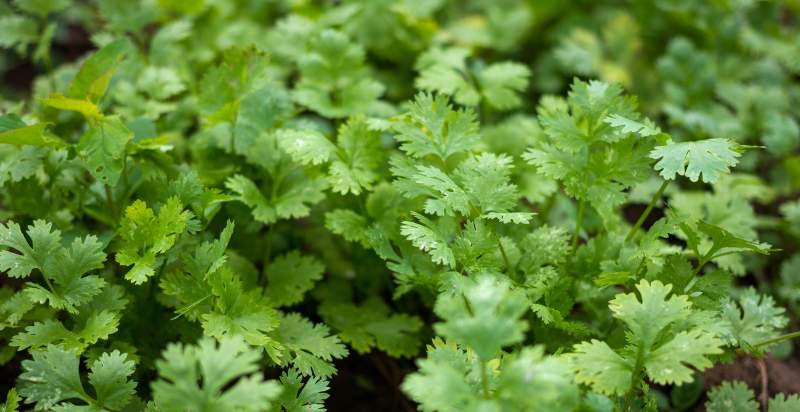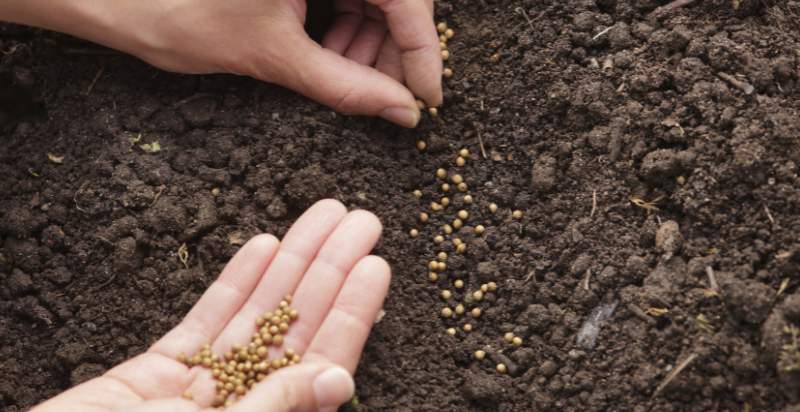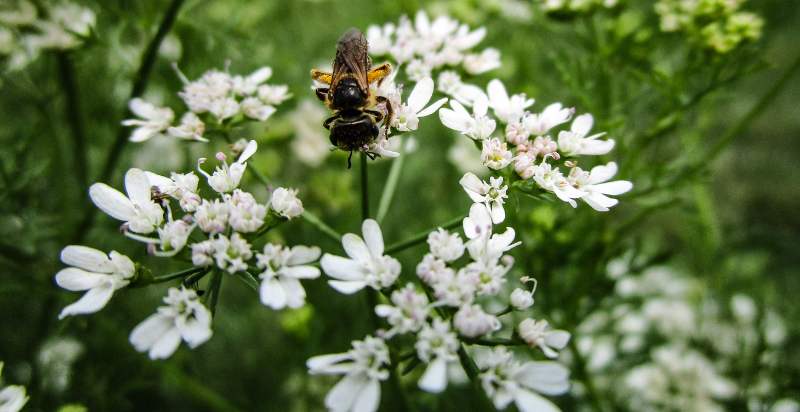As someone who’s spent countless hours with hands in the soil, I’ve come to know and love many plants, but cilantro holds a special place in my garden. Known scientifically as Coriandrum sativum, cilantro, or as some folks call it, coriander or Chinese parsley, is more than just an herb. It’s a staple in my kitchen, bringing fresh, vibrant flavors to dishes from all around the world.

This little plant, with its delicate green leaves and aromatic scent, is surprisingly easy to grow, making it a favorite among gardeners, myself included. Whether you’re sprinkling it fresh over a finished dish or using it as a key ingredient in a recipe, cilantro has the power to transform your cooking. And for us gardeners, the joy of harvesting cilantro straight from our own patch is unmatched. Let’s dive into the world of cilantro, a plant as versatile in the garden as it is in the kitchen.
The Unique Flavor of Cilantro
To some, cilantro is a burst of citrusy, leafy freshness that elevates any dish it graces. To others, it’s akin to munching on a bar of soap. This polarizing taste boils down to genetics. A specific gene affects how we perceive cilantro’s flavor, making it a fascinating herb to discuss around the dinner table. This “soap gene” creates a distinct experience for each person, making cilantro a topic as rich and varied as gardening itself.
History And Origin
Cilantro has a long history of being used in cooking and medicine. It was mentioned in the Bible, used by the Ancient Greeks to flavor their wines and as an aphrodisiac, and was also popular among the Romans. In India, cilantro is believed to ward off evil spirits and is included in many religious ceremonies. The plant is native to the Mediterranean region and parts of Asia but is now grown worldwide.
Cilantro Varieties and Flavor Profiles
Diving into the world of cilantro, you’ll find there are a few varieties out there, each with its own unique twist. Take Vietnamese cilantro, for example. It’s not your typical cilantro but brings a spicy, peppery flavor that’s fantastic in salads or as a garnish on those zesty Southeast Asian dishes. It’s a bit more robust in flavor, perfect for those who love a little kick in their meals.
Then there’s culantro, a cousin of cilantro that packs a punch with its strong, concentrated flavor. It looks different, with long, serrated leaves, but it’s used in similar ways, especially in Caribbean and Latin American cooking. It’s great for soups and stews, where it infuses the dish with deep, herbal notes.
Lemon coriander is another interesting variety. As the name suggests, it has a citrusy undertone that makes it a refreshing addition to fish dishes or citrus-based salads. It’s lighter in flavor, offering a subtle twist that can brighten up your meals.
Each of these cilantro varieties brings something special to the table. Whether you’re spicing up a soup with culantro, adding a peppery touch with Vietnamese cilantro, or brightening a dish with lemon coriander, there’s a whole world of flavors to explore.
Description
Cilantro consists of bright green, feathery leaves that grow from a thin stem. The plant has an upright habit and can reach up to 2 feet tall when mature. It produces small, white flowers in the summer, attracting bees and other beneficial insects.
Health Benefits
Cilantro isn’t just a tasty herb to sprinkle on your dishes; it’s packed with good stuff that can do wonders for your health. This little plant is a powerhouse of vitamins and minerals. It’s rich in Vitamin A, which is great for your eyesight, and Vitamin K, which is essential for bone health. Plus, it’s got Vitamin C, which is a real boost for your immune system, especially during those cold months.
Cilantro is also loaded with antioxidants. And for those who care about heart health, cilantro’s got you covered with its potassium content, which can help keep your blood pressure in check.
The herb is often touted for its potential detoxifying properties. It contains compounds that may help in detoxification processes in the body by aiding in the removal of heavy metals and other toxins. Some studies suggest that cilantro may help to increase the excretion of heavy metals like mercury, lead, and aluminum from the body.
Now, here’s a fun fact: cilantro can also be a natural breath freshener. Whenever you have a meal loaded with garlic or onions, chew on some cilantro leaves. It can help neutralize those odors, leaving your breath fresh and clean.
So, next time you chop cilantro for your salsa or curry, remember you’re not just adding flavor; you’re also boosting your meal’s nutritional value.
How to Plant and Grow a Cilantro Plant
Growing cilantro can be relatively easy as long as you provide the right conditions and take proper care of your plants. Read on to learn how to plant and grow cilantro successfully.
Step 1: Select the Right Spot
When looking for a spot to plant your cilantro, choose an area that receives full sun or partial shade, and make sure the soil is nutrient-rich and well-draining, as cilantro prefers moist but not soggy ground. If you plan on growing cilantro indoors, place the plant near a window where it can get at least 6-8 hours of sunlight per day.
Step 2: Preparing the Soil
When planting cilantro, ensure you have well-drained soil with plenty of organic matter. Cilantro grows best in full-sun locations with slightly acidic soil (pH 5–7). Adding compost or aged manure before planting will help ensure your plants get adequate nutrition.
Step 3: Plant Cilantro Seeds or Seedlings
The best way to begin growing cilantro is by planting either seeds or seedlings. You can sow your cilantro seeds directly into the soil, spacing them out by about 1-2 inches apart. Alternatively, purchase young plants from your local garden center and transplant them into your garden.

Step 4: Water Regularly and Fertilize when Needed
Cilantro likes to be kept moist but not soggy, so make sure to give your plants regular watering throughout the growing season. If you notice the leaves start to yellow or wilt, you may need to increase your watering frequency. Additionally, fertilize your cilantro plants every 2-3 weeks with a balanced fertilizer to provide them with the necessary nutrients they need to grow and thrive.
Hacks for Growing Cilantro Indoors
Let’s talk about growing this green goodness right in the cozy corners of our homes. No sprawling garden is required—just a sunny windowsill or a balcony will do!
- Cilantro loves the sun, so pick a windowsill or a balcony where it can bask in its golden rays.
- Grab a container—doesn’t have to be fancy. Old mason jars, recycled yogurt tubs, or even a shoebox with holes poked in the bottom will work. Just make sure it’s deep enough for cilantro roots to stretch out. A pot around 6-8 inches deep should do the trick.
- Attach some pots to a wooden plank and hang it vertically.
How to Care
- Pinch off Flowering Stems: Cilantro tends to bolt or flower and go to seed quickly. To prevent this from happening, it’s important to pinch off any flowering stems as soon as you notice them appearing. This will help encourage the plant to continue producing leaves instead of going into its flowering stage.
- Provide Proper Drainage: Ensure your cilantro plants are planted in an area with good drainage; otherwise, the roots may become waterlogged and cause the plant to rot. A raised bed or container is often better than planting directly in the ground when growing cilantro.
- Weed Regularly: Keeping weeds away from your cilantro plants is another important step in keeping them healthy. Be sure to regularly check for weeds and remove any that you find, as they can compete with your plants for water and nutrients.
Preventions From Pests and Diseases
Pests and disease can be a problem when growing cilantro, so it’s important to take steps to prevent them from occurring. Regularly inspect your plants for signs of insects or diseases and any damaged or wilted leaves.
If you notice anything unusual, treat your plants with an appropriate pesticide or fungicide. Additionally, practice crop rotation and avoid planting cilantro in the same spot every year to help reduce the risk of pest and disease buildup.
Harvesting Cilantro
When harvesting cilantro, wait until the plant is at least 6 inches tall before snipping off the stems. Make sure to only harvest what you plan on using right away; otherwise, store your cilantro in the refrigerator for up to 10 days.
Here are some additional tips for growing Cilantro:
- Plant cilantro in succession: Plant new batches of cilantro every few weeks to ensure a steady supply throughout the season.
- Mulch the soil: Use organic mulch such as straw or grass clippings around your plants to help keep the soil moist and protect them from weeds and pests.
- Choose varieties that are slow to bolt: Look for cultivars that are slower to bolt, such as ‘Slow Bolt’ or ‘Delilah.’ This will help you get a longer harvest season out of your cilantro plants!
- Water in the morning: Watering your plants early in the day will help reduce evaporation and give them enough time to dry off before nightfall.
These simple steps can help you grow cilantro in your garden and enjoy its fresh taste all season long!

How To Store Homegrown Cilantro
Keeping cilantro fresh can be a bit of a puzzle, but with a few tricks up your sleeve, you can enjoy this flavorful herb for longer. If you’ve just brought some cilantro home or picked it from your space, you can keep it fresh in the fridge by placing the stems in a jar of water, just like flowers. Cover the leaves with a plastic bag and pop it in the fridge. This little setup can keep your cilantro perky for up to two weeks.
Now, for those times when you have more cilantro than you can use quickly, freezing is a fantastic option. Chop up the cilantro and pack it into an ice cube tray, covering the bits with water or olive oil, then freeze. These cilantro cubes are perfect for tossing into soups, stews, or marinades whenever you need a burst of flavor.
Drying cilantro is another way to go, although it does lose some of its potent flavor. Simply hang bunches of cilantro upside down in a warm, dry place, and once dried, crumble the leaves and store them in an airtight container.
Potential Risks From Cilantro
Although cilantro is generally safe to consume, some people may experience an allergic reaction when eating it. Symptoms of a cilantro allergy can include itching, swelling, hives, and difficulty breathing.
If you experience these symptoms after consuming cilantro, seek medical attention immediately. Additionally, pregnant women should consult their doctor before consuming large amounts of cilantro as it may act as a stimulant and cause contractions.
As with all herbs and spices, it’s important to use fresh cilantro only in moderation to avoid overpowering the other flavors in your food. Enjoy the unique taste of this herb and add it to your dishes for a delicious kick!
Cilantro in Different Languages and Cultures
Cilantro goes by many names around the world, and it’s fascinating to see how it weaves into the fabric of so many cultures. In English, we often call it “cilantro,” derived from the Spanish word for the plant. But, head over to the UK or other parts of Europe, and you’ll hear it called “coriander leaves,” the name “coriander” itself coming from the French word “coriandre.”
In Arabic-speaking countries, it’s known as “kuzbara,” while in India, a land rich with cilantro in its cuisine, it’s called “dhania.” Each name reflects the unique linguistic tapestry of these diverse cultures. Beyond its names, cilantro holds a special place in culinary traditions worldwide. From the fresh, zesty salsas of Mexico to the aromatic curries of India, cilantro adds a burst of flavor that’s hard to replace.
What’s truly wonderful is how cilantro bridges cultures, finding its way into hearts and dishes across the globe.
Alternatives to Cilantro
For those who find cilantro’s taste a bit off-putting, fear not! There are plenty of other herbs out there that can fill the void and still add that fresh, green touch to your dishes. As someone who loves experimenting with flavors, I’ve found a few alternatives that might just do the trick.
Parsley is my go-to substitute. It’s got that fresh, green vibe without the soapiness some folks get from cilantro. It works great in salads, salsas, and garnishes, just like cilantro. Another fantastic alternative is Thai basil. It brings a sweet, slightly anise-like flavor that’s perfect in Asian dishes where you might usually use cilantro.
For those looking for a bit more of a peppery kick, try culantro. It’s related to cilantro but has a stronger taste. It’s not as widely available, but it’s worth seeking out for its robust flavor. Lastly, mint can be a refreshing substitute in some recipes, adding a cool, bright note.
Each of these herbs brings its own unique flavor to the table, and while they might not be exact replicas of cilantro, they offer delightful alternatives.
Cilantro in Global Cuisine
In Thai cuisine, cilantro adds a refreshing note to the iconic green curry, while in Mexico, it’s the star of zesty salsas that dance on tortilla chips. Over in India, cilantro shines in tangy chutneys, elevating every bite with its bright flavor.

Picture this: a fluffy bowl of cilantro rice, infused with its fresh aroma, or a zesty cilantro chimichurri drizzled over grilled meats, bringing a burst of flavor to the table. And for a creamy twist, whip up a cilantro cream sauce to jazz up your favorite dishes.
Did you know cilantro has a rich history too? It’s been gracing kitchens for centuries, prized for its unique taste and health benefits. Some even say it dates back to ancient civilizations!
So, next time you’re in the kitchen, don’t be shy to get creative with cilantro. Whether it’s a simple sauce, pesto, or dressing, let this herb add its magic to your culinary adventures!
Cilantro Pairings: Unexpected Flavors
- Cilantro + citrus (lime, orange) = refreshing zing
- Cilantro + coconut = tropical delight
- Cilantro + ginger = aromatic fusion
Hey there, did you know that cilantro offers more than just its leaves? Yup, its flowers and seeds are culinary gems too! Let’s dive into this tasty world beyond the leaves.
First up, cilantro flowers. They’re not just pretty; they’re edible and pack a milder flavor compared to the leaves. Sprinkle them on salads for a pop of color or use them as delicate garnishes on your favorite dishes. You can even infuse them into oils for a subtle cilantro essence that’ll elevate your cooking game.
Now, onto coriander seeds. Yep, those little guys come from cilantro plants too! They’re like the plant’s hidden treasure. Grind them up and throw them into spice blends for an extra kick, or use them in pickling to add a zesty touch. And don’t forget about baking – coriander seeds can add a unique flavor twist to bread and pastries that’ll have your taste buds singing.
So next time you’re in the kitchen, don’t just stick to the leaves. Get creative with cilantro’s flowers and seeds – they’re nature’s delicious surprises!
Cilantro in Mixology: Herb-Infused Cocktails
How about cilantro spicing up your drinks – yep, you heard it right, cilantro in cocktails and mocktails!
Try whipping up some cilantro-infused simple syrup. Just toss some cilantro leaves into your syrup as it simmers, let the flavors mingle, then strain it out for a herbaceous twist to your drinks.
Now, onto the cocktails! To make a cilantro mojito, muddle some cilantro leaves with lime and sugar, add rum and soda water, and voila – you’ve got yourself a refreshing, herb-infused drink that’ll transport you to a sunny beach.
And don’t forget the mocktails! Try cilantro-spiked lemonade – just blend cilantro with lemon juice, sugar, and water for a zesty, herbaceous sipper that’s perfect for any occasion.
Prepare these drinks for some herb-infused refreshment!
Beyond the Leaves: Utilizing Cilantro Flowers and Seeds
Did you know that cilantro offers more than just its leaves? Yup, its flowers and seeds are culinary gems too! Let’s dive into this tasty world beyond the leaves.

First up, cilantro flowers. They’re not just pretty; they’re edible and pack a milder flavor compared to the leaves. Sprinkle them on salads for a pop of color or use them as delicate garnishes on your favorite dishes. You can even infuse them into oils for a subtle cilantro essence that’ll elevate your cooking game.
Now, onto coriander seeds. Yep, those little guys come from cilantro plants too! They’re like the plant’s hidden treasure. Grind them up and throw them into spice blends for an extra kick, or use them in pickling to add a zesty touch. And don’t forget about baking – coriander seeds can add a unique flavor twist to bread and pastries that’ll have your taste buds singing.
So next time you’re in the kitchen, don’t just stick to the leaves. Get creative with cilantro’s flowers and seeds – they’re nature’s delicious surprises!
Conclusion
In conclusion, cilantro’s versatility knows no bounds, both in the garden and the kitchen. Its fresh, vibrant flavor can elevate dishes from around the globe, adding a unique twist to every bite. I encourage you to dive into the world of cilantro, whether it’s growing it in your garden or experimenting with it in your cooking. Share your experiences with cilantro and let’s keep the conversation going. Have questions or want to share your favorite cilantro recipe? Don’t hesitate to reach out. Together, let’s continue exploring the endless possibilities that cilantro has to offer. Happy cooking!
Learn the secrets of lulo’s health advantages and culinary delights by delving into our insightful article today
Addressing Common Questions (FAQs)
Can cilantro grow indoors?
Yes, cilantro can thrive indoors as long as it receives adequate sunlight, water, and well-draining soil. Place it near a sunny window or under grow lights for optimal growth.
Can cilantro replace parsley in recipes?
While cilantro and parsley have distinct flavors, cilantro can often substitute for parsley in recipes, especially in dishes with bold or spicy flavors. Experiment to see how it complements your dish!
Is cilantro the same as coriander?
Yes, cilantro and coriander come from the same plant. Cilantro refers to the leaves and stems, while coriander refers to the seeds. Both offer unique flavors and can be used in various culinary applications.
How to mitigate the soap taste for sensitive individuals?
Some people perceive a soapy taste when consuming cilantro due to genetics. To mitigate this, try using only the leaves (avoiding the stems) or incorporating cilantro into dishes with strong flavors that mask the soapy taste. Additionally, rinsing the cilantro thoroughly before use may help reduce the perceived soapiness.
- Everything You Wanted to Know About Red Tamarillos - June 2, 2025
- A Guide to Tulips: Everything You Need to Know & More… - June 2, 2025
- Guanabana: Description, Flavor, Benefits, And Uses - May 27, 2025

23 thoughts on “Cilantro Plant: How To Plant, Grow, And Harvest Coriander ”
Comments are closed.